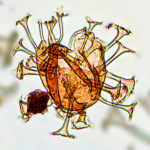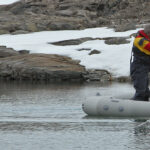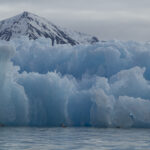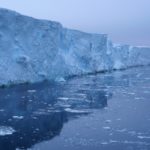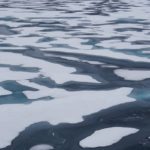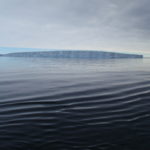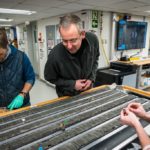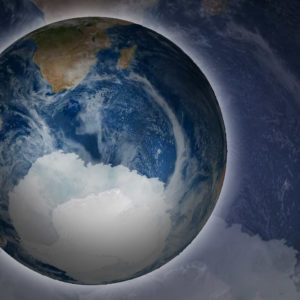Palaeo Environments, Ice Sheets and Climate Change team
Our ambition
is to improve understanding of the mechanisms of past change in ice sheets, oceans and global climate. Our aim is to reduce uncertainty in predictions of future climate and sea level change, informing Government strategy for mitigating against the risks of these changes. We specialise in providing detailed past and contemporary records of climate and environmental change from high latitude regions.

Team priorities
Science
To develop our understanding of the past response of polar ice sheets and ice shelves to environmental changes. Our aim is to improve forecasts of global sea levels and ice mass loss by providing data against which ice sheet models can be tested.
To investigate the history of the Southern Hemisphere Westerly Winds and their role in ice sheet dynamics and the global CO2 budget. We aim to detect when human impacts exceed the natural ranges of variability in the Earth system by studying climate signals in marine and terrestrial sediments.
To study changes in the production and export of Antarctic Bottom Water, the circulation of Southern Ocean deep- and bottom-water masses, and the role of sea ice, melt water and biological productivity in controlling past, and future, climate changes.
To improve understanding of the transition between greenhouse and icehouse climate states and the wider impact of global climate changes on the environment. We will study the physical environment, terrestrial and marine palaeobiology and community analysis from the geological past.
Technology, innovation and training
- Lead development of the science case and infrastructure requirement for the new UK Polar Research Vessel
- Utilise new and existing technologies to sample subglacial sediments to obtain records of past change; such as evidence for West Antarctic Ice Sheet loss and past ice shelf stability, and changes in subglacial hydrology and biology
- Apply and test novel dating techniques, and temperature and sea-ice proxies
- Train the next generation of polar scientists
Influencing and leading international programmes
- Play a strong leadership role and contribute to Scientific Committee for Antarctic Research (SCAR) Research Programmes (PAIS, AntEco), the International Geosphere Biosphere Programme (IGBP-PAGES), and Antarctic International Ocean Discovery Programme
- Participate in drilling initiatives including the International Ocean Discovery Program (IODP) and MeBo
Stakeholder engagement
- Produce policy briefings and presentations for UK Government departments including the Department of Business, Innovation and Skills (BIS) and the Foreign Office Polar Regions Department (FCO)
- Produce science updates and briefings on the impact and relevance of our research for our funders, including NERC
- Serve as Contributing Authors to the Intergovernmental Panel on Climate Change (IPCC) and UN Framework Conventions on Climate Change and the Law of the Sea
Public engagement in research
- Work with the BAS Communications Team to explain our science and its relevance for environmental stewardship to a wide range of public audiences
The role of Antarctic sea-ice in global climate
Sea-ice is frequently cited as a likely driver and propagator of abrupt climate change because of the rapid and far-reaching impact of its feedbacks. However, numerical climate models are still …The role of the Southern Ocean in regulating atmospheric CO2 on glacial-interglacial timescales
The cause of the variability in atmospheric CO2 over glacial-interglacial timescales has been a puzzle since its discovery in the early 1980s. It is widely believed to be related to …Impact of Southern Westerly Winds and Circumpolar Deep Water on climate and marine ecology
The Antarctic Peninsula has warmed ~3°C over the last 50 years, approximately 6 times faster than the global average. Mechanisms for this accelerated rate of warming have been linked with …Identification of glacial-time sources for Antarctic deep- and bottom-water masses
Over the past few millions of years, the Earth’s climate has switched between (cold) glacial and (warm) interglacial states many times. Although driven by long term changes in the Earth’s …Improving estimates of Antarctica’s contribution to sea level
This research aims to improve estimates of Antarctica’s contribution to sea level. Sea level is currently rising at approximately 3mm/yr. If we are to understand why it is rising and …Impacts of Ocean Acidification on Sea-Surface
In order to assess the impact of anthropogenic carbon dioxide (CO2) on the oceans today we are investigating the effect of decreasing upper ocean pH on calcifying zooplankton. Pteropods, …Impact of global disturbances on evolution of polar life
Why does global biodiversity show such a steep increase just as climates were deteriorating?Late Quaternary changes in the Westerly Winds over the Southern Ocean
In this NERC-funded project, we are generating Southern Hemisphere Westerlies (SHW) proxy records from each of the three major sectors of the Southern Ocean, focusing on subantarctic islands situated in …Arctic marine geophysics
This research focuses on investigating the glacial histories of Arctic ice sheets and ice caps using the marine geological record preserved on continental margins. By reconstructing past ice sheets, their …Depositional patterns and records in sediment drifts off the Antarctic Peninsula and West Antarctica
The biggest uncertainty in predictions of sea-level rise is what the contribution will be from the great ice sheets on Antarctica and Greenland as climate warms. The West Antarctic Ice …IMCONet
IMCONet is an international Research Network that follows an interdisciplinary approach to understand the consequences of Climate Change in coastal Western Antarctica. A Network for Staff Exchange and Training, IMCONet …Role of oceanic forcing in West Antarctic Ice Sheet retreat
Ocean temperature has been identified as a key driver of current ice sheet retreat in the Amundsen Sea sector of the West Antarctic Ice Sheet (WAIS), yet its long-term history …BEAMISH: Basal Conditions on Rutford Ice Stream
The polar ice sheets play a major role in controlling Earth’s sea level and climate, but our understanding of their history and motion is poor. The biggest uncertainty in predicting …ANiSEED
This project will reconstruct millennial-scale ice sheet change in the western Amundsen Sea Embayment, Antarctica, using high-precision exposure dating.Geological History Constraints on the Magnitude of Grounding Line Retreat in the Thwaites Glacier System
GHC (“Geological History Constraints”) will gather information about past ice sheet behaviour and relative sea level change in the Thwaites Glacier system. Determining the timing and magniture of past episodes …Stability and Instability – Records of External Drivers and Resulting Behaviour of Thwaites Glacier
THOR is a ship-based and ice-based project that will examine sedimentary record both offshore from the glacier and beneath the ice shelf, together with glacial landforms on the sea bed, …Scientists secure funding to study Greenland and North Atlantic climate tipping points
17 February, 2025
British Antarctic Survey (BAS) researchers have been selected for funding from The Advanced Research + Invention Agency (ARIA) to help improve our understanding of climate tipping points. These tipping points …
Historic drilling project finds ice over 1.2 million years old
9 January, 2025
The fourth Antarctic campaign of the Beyond EPICA-Oldest Ice project has achieved a historic milestone this week, by successfully drilling a 2800-metre-long ice core, consisting of ice from the Antarctic …
Antarctic drilling missions seek to understand climate and ice dynamics
12 December, 2024
Over 30 researchers from international institutes are working on ice core drilling campaigns in Antarctica to probe the ice sheet’s behaviour, carbon cycling in the Southern Ocean, and the Earth’s …
New field season on Thwaites Glacier underway
7 December, 2023
Thirty seven scientists and over 24 support staff are arriving in Antarctica to work on Thwaites Glacier. They are part of the ambitious international effort to understand the glacier and …
Team heads for Antarctica to study global warming effects
8 November, 2023
A research mission to Antarctica will study the effects of global warming on the West Antarctic ice sheet. The mission is part of an international research programme, which includes researchers …
Increasing ship traffic in Inuit Nunangat
17 August, 2023
Researchers from British Antarctic Survey are heading to the Canadian Arctic this week to learn more about the impacts of increasing ship traffic in Inuit Nunangat. In recent years, climate …
Rocks beneath Antarctic Ice Sheet reveal surprising past
30 May, 2023
The West Antarctic Ice Sheet is shrinking, with many glaciers across the region retreating and melting at an alarming rate. However, this was not always the case according to new …
Sea butterfly life cycle threatened by climate change
15 May, 2023
Shelled pteropods, commonly known as sea butterflies, are increasingly exposed to ocean changes, but some species are more vulnerable to this threat. In a new study, published this month (11 …
Fieldwork starts on Thwaites Glacier
13 December, 2022
Nearly 60 scientists and support staff are on their way to Thwaites Glacier in West Antarctica. It’s part of an ambitious international effort to understand the glacier and surrounding ocean …
Oldest marine DNA discovered in Antarctic sediments
14 October, 2022
Scientists have discovered one million year old marine DNA in deep-sea sediments of the Scotia Sea, north of the Antarctic continent. This is the oldest DNA recovered of this kind …
Ice age valleys give clues to future ice sheet change
5 October, 2022
Deep valleys buried under the seafloor of the North Sea record how the ancient ice sheets that used to cover the UK and Europe expelled water to stop themselves from …
Seafloor images explain Thwaites Glacier retreat
5 September, 2022
New high resolution images of the the seafloor in West Antarctica show past retreat of Thwaites Glacier. They reveal that at times in its past, retreat of the massive Thwaites …
Drilling of oldest ice on Earth completed
18 February, 2022
The first ice core drilling campaign of Beyond Epica-Oldest Ice has been successfully completed at the remote Little Dome C site in Antarctica – one of the most extreme places …
Abundance of life discovered beneath an Antarctic ice shelf
20 December, 2021
Far beneath the ice shelves of the Antarctic, there is more marine life than expected, finds a recent study in the journal Current Biology, published this week (20 December 2021). …
‘MRI’ scan reveals spectacular ice age landscapes beneath the North Sea
9 September, 2021
Spectacular ice age landscapes beneath the North Sea have been discovered using 3D seismic reflection technology. Similar to MRI (magnetic resonance imaging) the images reveal in unprecedented detail huge seafloor …
IPCC: Polar scientists welcome Climate Change Assessment
9 August, 2021
CAMBRIDGE: British Antarctic Survey welcomes the publication of the Intergovernmental Panel on Climate Change (IPCC) Working Group 1 component of its Sixth Assessment Report. This assessment brings together the latest advances in …
Scientists reconstruct past history of largest ice shelf on Antarctic Peninsula
19 May, 2021
For the first time, geological records have been used to reconstruct the history of Larsen C Ice Shelf in Antarctica. The ice shelf is the largest remaining remnant of a …
Underwater robot reveals how Thwaites Glacier is melting
19 April, 2021
For the first time, researchers have collected data from underneath the remote Thwaites Glacier in West Antarctica using an underwater robot.
Southern Hemisphere westerly winds likely to intensify as climate warms
9 December, 2020
Polar climate scientists have created the most high resolution past record of the Southern Hemisphere westerly winds. The results, published this week (9 December) in the journal Communications Earth and …
Deep channels link ocean to Antarctic glacier
9 September, 2020
Newly discovered deep seabed channels beneath Thwaites Glacier in West Antarctica may be the pathway for warm ocean water to melt the underside of the ice. Data from two research …
Past evidence supports complete loss of Arctic sea-ice by 2035
10 August, 2020
A new study, published this week in the journal Nature Climate Change, supports predictions that the Arctic could be free of sea ice by 2035. High temperatures in the Arctic …
Traces of rainforests found in West Antarctica
1 April, 2020
An international team of researchers has provided a new and unprecedented perspective on the climate history of Antarctica. From a sediment core collected from the seafloor in West Antarctica, they …
Scientists drill for first time on remote Antarctic Glacier
28 January, 2020
Teams from the US and UK have successfully completed scientific fieldwork in one of the most remote and hostile areas of West Antarctica – coinciding with the 200th anniversary of …
Scientists head to Antarctica’s Thwaites Glacier
14 November, 2019
Nearly 100 scientists and support staff depart this week (13 November 2019) for the most ambitious mission to date for Thwaites Glacier in West Antarctica. In the second year of …
Marine life recovery following the dinosaurs’ extinction
19 June, 2019
A new study shows how marine life around Antarctica returned after the extinction event that wiped out the dinosaurs. A team led by British Antarctic Survey studied just under 3000 …
Seals to act as sentinels of remote Antarctic glacier
29 January, 2019
Scientists will use two species of seals to investigate a huge glacier in West Antarctica that is at risk of collapse. A team of over 20 polar scientists from the …
International research expedition heads to West Antarctica
28 January, 2019
An international team of scientists is travelling to the Amundsen Sea – one of the most vulnerable sectors of the Antarctic Ice Sheet – to answer vital scientific questions about …
Ice sheets growing from the base
7 November, 2018
Fresh water freezing onto the bottom of the Greenland and Antarctic Ice Sheets leads to the formation of spectacular plume-shaped features, according to new research published today (7th November) in …
Increases in winds weaken Southern Ocean carbon sink
23 July, 2018
A new study of lake sediments from the sub-Antarctic reveals for the first time that increases in westerly winds are likely to reduce the ability of the Southern Ocean to …
New maps show why glacier ice front suddenly shrank
15 June, 2018
Pine Island Glacier in West Antarctica is one of the fastest-flowing glaciers in Antarctica. Over the last eleven years, four major icebergs have broken off from its floating ice shelf. …
Major shift in marine life occurred 33 million years later
17 May, 2018
A new study of marine fossils from Antarctica, Australia, New Zealand and South America reveals that one of the greatest changes to the evolution of life in our oceans occurred …
Giant West Antarctic iceberg disintegrates
29 November, 2017
An animation of the giant iceberg that calved off the Pine Island Glacier in West Antarctica just over two months ago shows an unexpected break up. Satellite images revealed a …
‘Scars’ left by icebergs record West Antarctic ice retreat
25 October, 2017
Thousands of marks on the Antarctic seafloor, caused by icebergs which broke free from glaciers more than ten thousand years ago, show how part of the Antarctic Ice Sheet retreated …
FEATURED PAPER: Wind, warm water and ice-sheet loss
5 October, 2017
Wind-driven incursions of warm, deep water forced the retreat of West Antarctic glaciers from the end of the last ice age until 7,500 years ago and since the 1940s. These …
Large iceberg breaks off Pine Island Glacier
27 September, 2017
Latest satellite images reveal a new 100-square-mile iceberg emerging from Antarctica’s Pine Island Glacier. The calving event did not come as a complete surprise, but is a troubling sign with …
Team discovers sub-glacial lake from over 20,000 years ago
20 June, 2017
Researchers have provided new evidence that large sub-glacial lakes existed under the West Antarctic Ice Sheet during the last glacial period – around 20,000 years ago – a period when …
New atlas provides highest-resolution imagery of the Polar Regions seafloor
25 April, 2017
The most comprehensive and high-resolution atlas of the seafloor of both Polar Regions is presented this week (Tuesday 25 April) at the European Geosciences Union General Assembly (EGU) in Vienna.
Penguin colony repeatedly decimated by volcanic eruptions
11 April, 2017
One of Antarctica’s biggest gentoo penguin colonies was repeatedly decimated by eruptions of the Deception Island volcano in recent millennia.
Ice cap once covered sub-antarctic island of South Georgia
17 March, 2017
A new study reveals the sub-antarctic island of South Georgia – famous for its wildlife – was covered by a massive ice cap during the last ice age. The results …
New study shows when Pine Island Glacier retreat began
23 November, 2016
New study reveals when West Antarctica’s largest glacier started retreating Reporting this week (Wednesday 23 November) in the journal Nature an international team led by British Antarctic Survey (BAS) explains …
NEWS STORY: Oxygen depletion in the upper waters of the Southern Ocean during glacial periods
31 March, 2016
Research published this week by an international team of scientists, including the British Antarctic Survey, provides new insights into how carbon dioxide changed in the oceans surrounding Antarctica during glacial …
NEWS STORY: Lake drainage affected climate
17 February, 2016
The catastrophic release of fresh water from a vast South American lake at the end of the last Ice Age was significant enough to change circulation in the Pacific Ocean …
PRESS RELEASE: New season – ambitious science
23 November, 2015
New season tackles ambitious science and logistical challenges The British Antarctic Survey (BAS) 2015/16 field season is underway with dozens of scientists and support staff – together with planes and tonnes …
NEWS STORY: Sea-level rise from Antarctic collapse
19 November, 2015
Sea-level rise from Antarctic collapse may be slower than suggested A new study by scientists in the UK and France has found that Antarctic ice sheet collapse will have serious …
FEATURED PAPER: Ocean upwelling and increasing winds
2 September, 2015
As the southern westerly winds drive the Antarctic circumpolar current around Antarctica, deep waters are forced up to the surface south of the polar front. Changes in the intensity with …
NEWS STORY: Predicting polar ice loss
28 August, 2015
Most comprehensive ice loss model A new international study is the first to use a high-resolution, large-scale computer model to estimate how much ice the West Antarctic Ice Sheet could …
PRESS RELEASE: Ice shelf at double risk
13 May, 2015
New study shows Antarctic ice shelf is thinning from above and below A decade-long scientific debate about what’s causing the thinning of one of Antarctica’s largest ice shelves is settled …
NEWS STORY: IPCC climate report published today
27 September, 2013
The Fifth Assessment Report (AR5) of the Intergovernmental Panel on Climate Change (IPCC) is published today. The report entitled Climate Change 2013: The Physical Science Basis, presents a synthesis of …
PRESS RELEASE: Antarctica’s climate timeline
22 August, 2012
New climate history adds to understanding of recent Antarctic Peninsula warming Results published this week by a team of polar scientists from Britain, Australia and France adds a new dimension …
PRESS RELEASE: Ocean currents driving ice loss
25 April, 2012
Warm ocean currents cause majority of ice loss from Antarctica Reporting this week (Thursday 26 April) in the journal Nature, an international team of scientists led by British Antarctic Survey …
PRESS RELEASE: Ozone hole anniversary
5 May, 2010
25th Anniversary of the Discovery of Ozone Hole This week British Antarctic Survey (BAS) commemorates the 25th anniversary of one of its most dramatic scientific discoveries — the ozone hole. …
Blog: Hunting for microplastics in the high Arctic
23 August, 2022 by Huw Griffiths
Huw Griffiths works in the Biodiversity Team at British Antarctic Survey. As he completes fieldwork in the Canadian Arctic with colleagues Cath Waller (University of Hull) and Steve Roberts (BAS), …
A new drill site in the Amundsen Sea
27 March, 2019 by Claus-Dieter Hillenbrand
Dr Claus-Dieter Hillenbrand is aboard the drill ship JOIDES Resolution as part of the 8-week International Ocean Discovery (IODP) Expedition 379. This is the final entry in a series of …
“Core on deck” – Analysis begins
18 March, 2019 by Claus-Dieter Hillenbrand
Dr Claus-Dieter Hillenbrand tells us more about what happens once a sediment core has been recovered from the seafloor.
“Core on deck” – a welcome announcement
14 March, 2019 by Claus-Dieter Hillenbrand
Dr Claus-Dieter Hillenbrand describes what it’s like drilling sediment cores on International Ocean Discovery (IODP) Expedition 379 in the Amundsen Sea, West Antarctica. Since the 31st of January we have …
Another research expedition but this time quite different
19 February, 2019 by Claus-Dieter Hillenbrand
Dr Claus-Dieter Hillenbrand is a marine geologist at British Antarctic Survey (BAS). He is one of two UK scientists participating in International Ocean Discovery (IODP) Expedition 379 to the Amundsen …
SCIENCE AT SEA: Surveys and Sediments
27 March, 2018 by Matthew Chadwick
Matthew Chadwick is a member of the science team from British Antarctic Survey (BAS) currently aboard the RRS Discovery. Read on to gain an insight into what the team have …
SCIENCE AT SEA: Setting off for the Scotia Sea
15 March, 2018 by Zoe Roseby
Zoë Roseby is a member of the science team from British Antarctic Survey (BAS) currently aboard the RRS Discovery. Read on to discover what the team will be investigating in …
ANTARCTIC BLOG: Extreme Geology #11
12 February, 2016 by Joanne Johnson
After our extended period of lie-up, I now have the slightly surreal pleasure of sitting at Rothera writing this, contemplating flying home tomorrow. We flew back from the field on …
ANTARCTIC BLOG: Extreme Geology #9
29 January, 2016 by Iain Rudkin
January the twenty sixth. My pre-deployment brief suggested that I should currently be partaking of all the luxuries Rothera Research Station has to offer. Enjoying that period of self-satisfaction which …
ANTARCTIC BLOG: Extreme Geology #8
27 January, 2016 by Joanne Johnson
Reflections from the ANiSEED team in Marie Byrd Land Field Guide Al Docherty recounts his most memorable day of the field season so far: “7am the alarm goes off. I look …
ANTARCTIC BLOG: Extreme Geology #7
27 January, 2016 by Joanne Johnson
Every person who works in Antarctica has a different experience and takes away different memories because our perception is shaped so much by our previous life experiences. The four of …
ANTARCTIC BLOG: Extreme Geology #6
11 January, 2016 by Joanne Johnson
The challenges of glacier travel The ANiSEED project field area lies between two of the most rapidly changing glaciers in Antarctica, the Smith and Kohler Glaciers. These have thinned more …
ANTARCTIC BLOG: Extreme Geology #5
5 January, 2016 by Joanne Johnson
Greetings from Marie Byrd Land! The waiting is over….we finally arrived at our field site on 11th December, after a 4 hour flight from Sky Blu one of BAS’s fuel …
ANTARCTIC BLOG: Extreme Geology #4
12 December, 2015 by Joanne Johnson
Geologist Jo Johnson waits patiently to go deep-field
ANTARCTIC BLOG: Extreme Geology #3
19 November, 2015 by Joanne Johnson
Being a parent working in Antarctica
ANTARCTIC BLOG: Extreme Geology #2
12 November, 2015 by Joanne Johnson
A long drive ahead….update from polar guides preparing for a geology project in remote Marie Byrd Land Whilst Steve Roberts and I are preparing to depart the UK for Rothera …
ANTARCTIC BLOG: Extreme Geology #1
7 October, 2015 by Joanne Johnson
Science team goes deep field to Marie Byrd Land
ARCTIC BLOG: It’s not all plain sailing at the top of the World
21 August, 2015 by Kelly Hogan
A scientist’s view from Petermann Fjord, NW Greenland Three-and-a-bit days is what it takes to get from London to Thule air base in northwest Greenland. A quick flight to Copenhagen …
Chapter 8: Pollution in Antarctica
17 April, 2025 by Kevin Hughes, Michael Meredith, Rebecca Peel, Stephen Roberts
This chapter examines the historical legacy of human activities in and around Antarctica and assesses pollutants from the mid-late 20th century onwards that will have lasting impacts, potentially thousands of…Twenty‐thousand‐year gap between deglaciation and peat formation on sub‐Antarctic Marion Island attributed to climate and sea level change
1 April, 2025 by Alexander Whittle, Dominic Hodgson
Radiocarbon dating of basal peats has been a key factor in determining minimum ages for deglaciation on sub-Antarctic islands. On Marion Island, peat bogs dominate the landscape below 300 m a.s.l.,…Recent benthic foraminifera communities offshore of Thwaites Glacier in the Amundsen Sea, Antarctica: implications for interpretations of fossil assemblages
20 March, 2025 by Claus-Dieter Hillenbrand, James Smith, James Kirkham, Kelly Hogan, Robert Larter, Svetlana Radionovskaya
Benthic foraminiferal assemblages are useful tools for paleoenvironmental studies but rely on the calibration of live populations to modern environmental conditions to allow interpretation of this proxy downcore. In regions…Use of excess meltwater from continuous flow analysis systems for the analysis of low concentration insoluble microparticles in ice cores
13 March, 2025 by Claire Allen, Dieter Tetzner, Jack Humby, Liz Thomas
Low-concentration insoluble microparticles that are preserved in ice cores offer valuable information for reconstructing past environmental changes. However, their low concentrations and limited sample availability present challenges for extraction and…Bedmap3 updated ice bed, surface and thickness gridded datasets for Antarctica
10 March, 2025 by Alice Fremand, Andy Smith, David Vaughan, Ed King, Elena Field, Fausto Ferraccioli, Hugh Corr, Hamish Pritchard, James Kirkham, Peter Fretwell, Richard Hindmarsh, Tom Jordan, Richard Hindmarsh
We present Bedmap3, the latest suite of gridded products describing surface elevation, ice-thickness and the seafloor and subglacial bed elevation of the Antarctic south of 60 °S. Bedmap3 incorporates and…Read more on Bedmap3 updated ice bed, surface and thickness gridded datasets for Antarctica
A circumpolar review of the breeding distribution and habitat use of the snow petrel (Pagodroma nivea), the world’s most southerly breeding vertebrate
1 March, 2025 by Dominic Hodgson, Peter Fretwell, Richard Phillips
Knowledge of the spatial distribution of many polar seabird species is incomplete due to the remoteness of their breeding locations. Here, we compiled a new database of published and unpublished…Poleward displacement of the Southern Hemisphere Westerlies in response to Early Holocene warming
28 February, 2025 by Bianca Perren, Dominic Hodgson
Recent intensification of the Southern Hemisphere Westerlies has resulted in important changes to ocean circulation, Antarctic ice shelf stability and precipitation regimes in the continents abutting the Southern Ocean. Efforts…Mid-Holocene sea-ice dynamics and climate in the northeastern Weddell Sea inferred from an Antarctic snow petrel stomach oil deposit [EGUSphere preprint]
25 February, 2025 by Dominic Hodgson
Understanding past variability in Antarctic sea ice is of critical importance to determine how it regulates global climate processes and biogeochemistry, and Southern Ocean marine ecosystems. Records of changes in…Glacial geology of the Hudson Mountains, Amundsen Sea sector, West Antarctica
15 February, 2025 by Dominic Hodgson, James Smith, Joanne Johnson, Teal Riley
The Hudson Mountains are situated in the eastern Amundsen Sea sector of the West Antarctic Ice Sheet, adjacent to Pine Island Glacier. They form a volcanic field of 17 stratovolcanoes…Read more on Glacial geology of the Hudson Mountains, Amundsen Sea sector, West Antarctica
Lateral Fluxes Drive Basal Melting Beneath Thwaites Eastern Ice Shelf, West Antarctica
3 February, 2025 by James Smith, Keith Makinson, Keith Nicholls, Paul Anker, Peter Davis
Thwaites Glacier is one of the fastest-changing ice-ocean systems in Antarctica. Basal melting beneath Thwaites' floating ice shelf, especially around pinning points and at the grounding line, sets the rate…Read more on Lateral Fluxes Drive Basal Melting Beneath Thwaites Eastern Ice Shelf, West Antarctica
Assessing the suitability of sites near Pine Island Glacier for subglacial bedrock drilling aimed at detecting Holocene retreat–readvance
24 January, 2025 by Joanne Johnson
Unambiguous identification of past episodes of ice sheet thinning below the modern surface and grounding line retreat inboard of present requires recovery and exposure dating of subglacial bedrock. Such efforts…Surveying the deep: A review of computer vision in the benthos
22 January, 2025 by Cameron Trotter, Huw Griffiths, Rowan Whittle
The analysis of image data for benthic biodiversity monitoring is now commonplace within the domain of marine ecology. Whilst advances in imaging technologies have allowed for the collection of vast…Read more on Surveying the deep: A review of computer vision in the benthos
A dataset of Antarctic ecosystems in ice-free lands: classification, descriptions, and maps
22 January, 2025 by Dominic Hodgson, Kevin Hughes, Peter Convey
Antarctica, Earth’s least understood and most remote continent, is threatened by human disturbances and climate-related changes, underscoring the imperative for biodiversity inventories to inform conservation. Antarctic ecosystems support unique species…Remote mapping of bedrock for future cosmogenic nuclide exposure dating studies in unvisited areas of Antarctica
17 January, 2025 by Jonathan Adams, Joanne Johnson, Stephen Roberts
Cosmogenic nuclide exposure dating is an important technique for reconstructing glacial histories. Many of the most commonly applied cosmogenic nuclides are extracted from the mineral quartz, meaning sampling of felsic…Antarctica’s Thwaites Glacier and sea-level rise – Results from the International Thwaites Glacier Collaboration (ITGC) [Environment Audit Committee call for evidence]
16 January, 2025 by Peter Davis, Robert Larter
Executive Summary: Change to Thwaites Glacier in West Antarctica, sometimes referred to as the “Doomsday Glacier”, over the coming decades and centuries will have profound implications for global sea-level rise…Perspectives on using peat records to reconstruct past atmospheric Hg levels
15 January, 2025 by Dominic Hodgson, Stephen Roberts
Anthropogenic mercury (Hg) emissions to the atmosphere have increased the concentration of this potent neurotoxin in terrestrial and aquatic ecosystems. The magnitude of regional variation in atmospheric Hg pollution levels…Read more on Perspectives on using peat records to reconstruct past atmospheric Hg levels
Lessons learned from shallow subglacial bedrock drilling campaigns in Antarctica
1 January, 2025 by Joanne Johnson
We review successes and challenges from five recent subglacial bedrock drilling campaigns intended to find evidence for Antarctic Ice Sheet retreat during warm periods in the geologic past. Insights into…Read more on Lessons learned from shallow subglacial bedrock drilling campaigns in Antarctica
Glaciomarine sediments and processes
1 January, 2025 by James Smith, Kelly Hogan
During Quaternary glaciations, ice sheets expanded from continental interiors across continental shelves and delivered large volumes of sediment, transported by meltwater, and icebergs to the marine environment. Glaciomarine sediments preserve…Antarctic Waters
1 January, 2025 by Claire Allen, Dieter Tetzner
Here, we summarize the diatom research topics and applications that have the broadest relevance and importance for Antarctic studies. From the Southern Ocean we focus on biogeography, sea surface temperature…Science Leader
Deputy Science Leader
Share this
Featured

Science strategy

Private: Our Grand Challenges for polar science

Climate & climate change

Climate science – influencing policy








